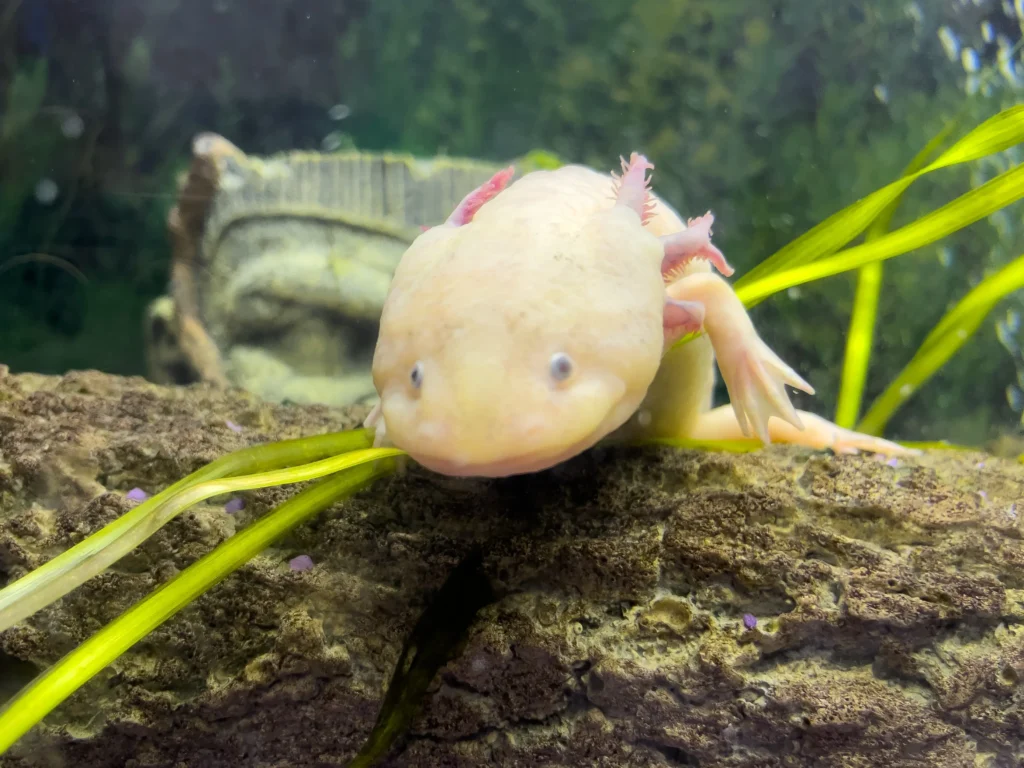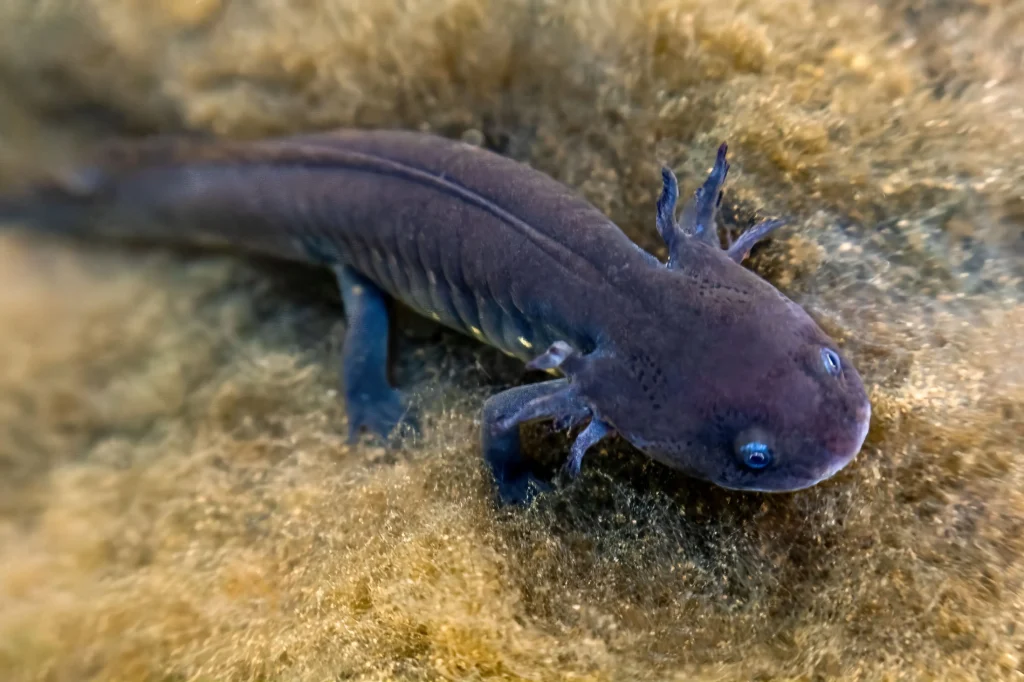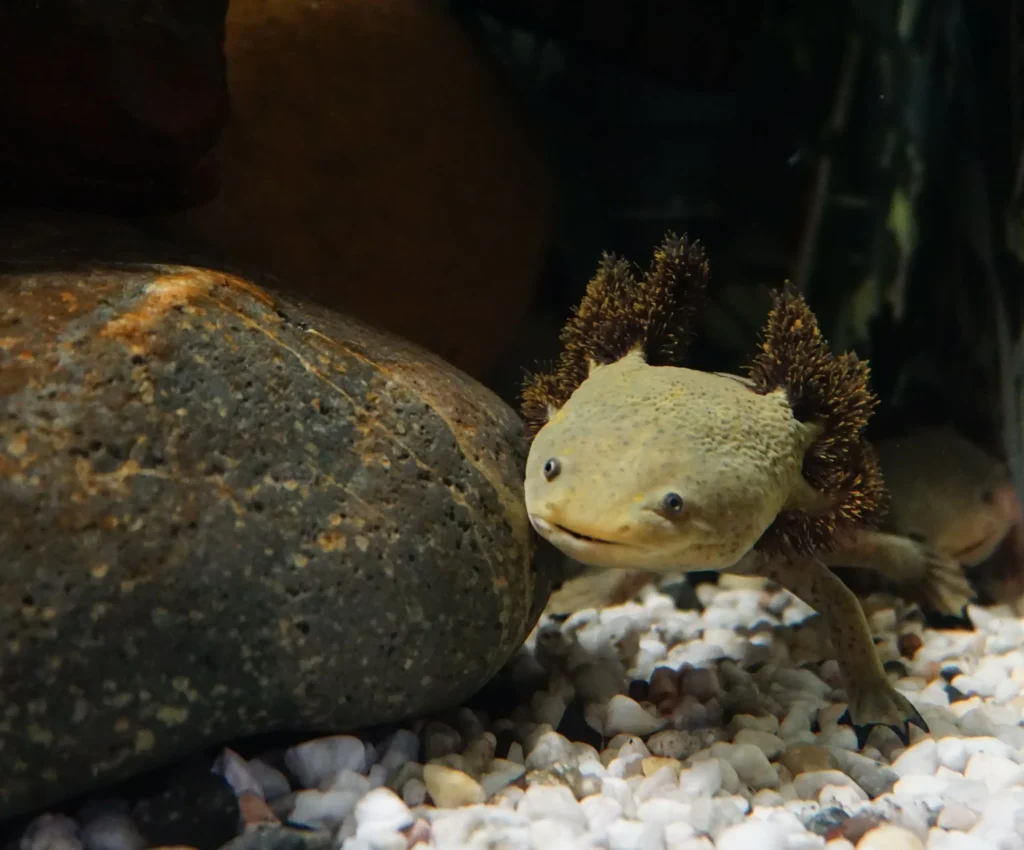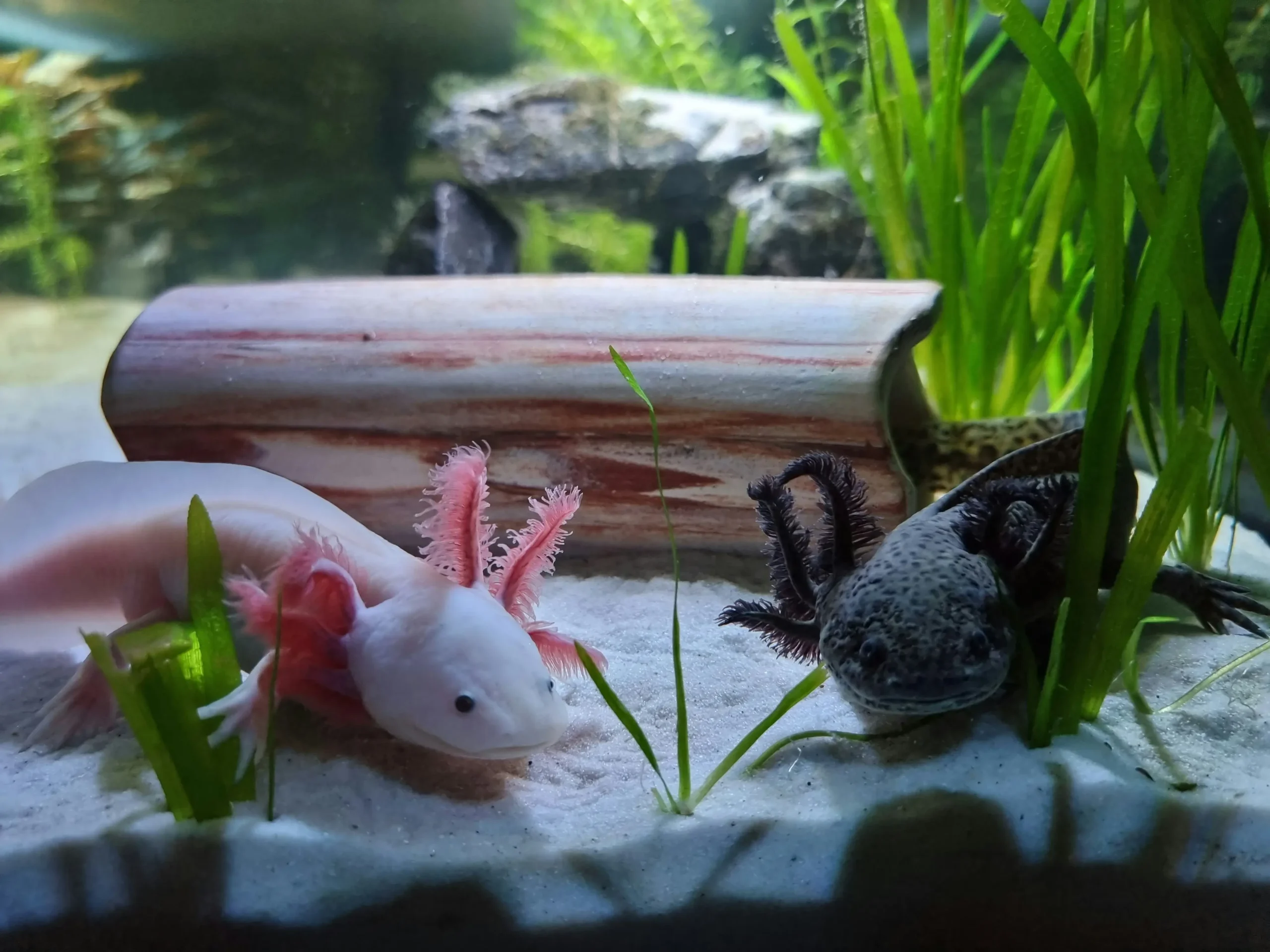Thinking about housing more than one axolotl, but unsure about the safety? It’s generally recommended to avoid keeping them together in a single tank. Still, you can do so (in a few cases) after considering risks like cannibalism, tank size, and whether your filtration system can handle the extra load.
Here, I’ll help you decide if cohabitating axolotls is the right move for you. I’ll share multiple scenarios, risks, considerations, and how to introduce them safely. Let’s get started.
Table of Contents
Can Axolotls Actually Live Together?
The answer depends upon your growing conditions, axolotl size, gender, tank space, and feeding habits.
Two axolotls can live together if they are the same size and of the same sex. That’s the only scenario of keeping them together safely.
By nature, axolotls are not aggressive and won’t fight, but there are potential risks of injury, cannibalism, and accidental breeding. Axolotls can live together under controlled conditions and careful management. But it’s never without risks and not recommended for beginners. Juvenile axolotls need more food, and the chances of them bullying the adults are high.
Also, one of the major concerns is maintaining water quality. Axolotls are organisms with high bioload. They are messy creatures and generate a lot of waste, so growing multiple axolotls is a tough job. Excessive bioload results in large concentrations of nitrates in the water tank, disturbing your cycling. Also, their presence for an extended period may stress the organisms, so choosing an appropriate tank size is a must.
| Scenario | Risks | Considerations |
| Single Adult Axolotl per Tank | Minimal risks (wisely select the substrate in the tank to avoid accidental ingestion and impaction problems) | Simplest setup, easiest to maintain water quality and easy to feed your lotls. Recommended for beginners. |
| Two Adults of Similar Size | Nipping, missing gills, tail, toes and fingers, stresses both axolotls, competition for space and food | Requires a big setup, a large tank, excellent filtration, hiding places, and enough space for each axolotl. Frequent feeding to avoid nibbling. Always have an emergency plan in case of serious injury |
| Adults and Juveniles | High risk of cannibalism, (adult eats juvenile because of size difference) and sometimes juveniles compete for food and eat the tail and toes of the adult. There is also a risk of impaction. | Strongly against the cohabitation of an adult and a juvenile. Reported cases are documented in various forums, therefore, don’t even take a risk. |
| Juveniles of Significantly Different Sizes | Juveniles are growing axolotls that need more food, and they are always hungry, in my opinion. There is a high risk of larger juveniles eating smaller ones. Additionally, it’s hard to predict an axolotl’s gender in the juvenile stage, so the chances of accidental breeding are high. | Avoid large size disparities for the safety of both organisms. Better not to keep them together. |
| Juveniles of Similar Size | Nipping, missing gills and parts of the body, injury risks, and potential cannibalism as they grow. If both end up opposite sexes, then accidental axolotl breeding is also a serious issue for pet owners. | Requires close monitoring, ample space/hides to break the line of sight of another. Not recommended for beginners |

Mixing Opposite Sex Axolotls
If a mature male and a mature female axolotl cohabitate in a water tank, they will surely breed. This leads to serious ethical, physical, and mental issues for axolotls and pet owners.
For instance, a female lays hundreds of eggs, and not everyone can afford to raise multiple axolotls. It is costly and requires serious commitment. Even if you plan to raise the hatchlings and you don’t have a proper care guide or knowledge, or are unable to provide stable conditions, you will end up killing them. Discarding unwanted eggs comes with a responsibility. The humane way to get rid of them is culling.
Moreover, a female axolotl can safely lay eggs after 6 months. Its body needs rest and time to recover from the whole process, so female axolotls should be bred only twice a year. Males do not know when to stop breeding, and if you leave them unattended, the female axolotl will die while forced to lay eggs every other month.
The only method to avoid breeding is to separate them permanently. Do not use tank dividers to prevent breeding, as they are unreliable. Also, axolotl gender cannot be predicted until they are 1 year old. Therefore, determining the gender of juveniles is impossible. If the tank mates are of the opposite sex, breeding can occur. So, better not to keep them together.
The only way to differentiate between them is through the cloaca shape and body appearance, which changes with maturity. Differentiating sexual characteristics in males is possible after 6-8 months. However, females cannot be confirmed until they are 18 months old.
An important ethical concern in axolotl breeding is to prevent inbreeding. If a related axolotl is bred, the offspring will inherit the resistant traits, potentially threatening their life expectancy and development.
The Main Threat: Cannibalism and Injury
Axolotls are calm and playful creatures unless they are in search of food. They are known to eat anything that fits in their mouth, such as stones, gravel, decorations, and even limbs of other axolotls, though the risk of impaction increases with it, but they won’t care. If the head of one axolotl fits in the mouth of another, guess where the other axolotl will end up? Yes, in the stomach of your other axolotl.
Axolotls are not active hunters but opportunistic predators. This means they wait for the prey to come near their mouth and quickly swallow it. So, if the axolotl tank mate’s head comes near, it may munch it whole.
Typically, juveniles and hatchlings are aggressive, and people often witness them nipping at tank mates’ gills, fingers, and tails. But adults can also harm the tank mates. Their bite is strong enough to cause traumatic injury, break bones, rip off tails, and even cut off the limbs of tank mates. Axolotl grows back the injured or missing parts due to regenerative abilities, but the injury can lead to stress, infection, or death in severe cases.
To avoid cannibalism or nipping, you should feed the axolotl well. Axolotl is attracted towards the movements and wiggling motion of worms. Even if you put dead food in the water, they might ignore it as live food attracts them.
Decorate the tank with plenty of items to minimise their interaction and break the line of sight. Growing axolotls of the same size will not eliminate the chance of injury, but minimizes the risk of cannibalism.
In case of an emergency, such as a serious injury to one or both axolotls, you must separate and tub one of them. Keep the injured axolotl separated while it heals and regrowing its limbs. When this happens, consult your veterinarian for professional care. Remember that during regeneration, axolotls are more prone to infection. Therefore, water quality should be maintained, and the nitrate level should be kept as low as possible.
Once an axolotl cannibalizes its sibling, there is a high chance that it will become a “cannibal morph.” If this happens, it cannot be reversed because of some physiological changes, such as a change in head shape and wider jaws. It is reported that Cannibal morphs also show active predatory behavior.

How to Create a Safe Multi-Axolotl Habitat
Although growing multiple axolotls in a water tank has some risks, there are also some success stories. Many people keep them without any issues.
If you plan to keep multiple axolotls in the same tank, the maximum limit is two. Trust me, and don’t think of three.
Now, what should be the right size tank? Axolotls will compete for space, so ensure the tank is spacious enough so that they won’t bump into each other. A recommended tank size for one axolotl is 22 gallons. For two axolotls, you can add an additional 10 gallons.
Axolotls prefer wide tanks to deep ones because of more floor space. They spend most of their time in the bottom region rather than swimming in the upper areas of the tank. A longer tank provides horizontal space, which can prevent accidental nipping and overcrowding during feeding. Also, a larger tank surface provides a larger surface area for the growth of beneficial bacteria.
Here are some further requirements:
| Requirement | Minimum Standard | Why It’s Important |
| Tank Size | 30L + 10 gallons per additional adult | Provides adequate floor space for walking and exploring the bottom, enough for separation and minimum interaction, and reduces stress. |
| Filtration | You need an excellent filter due to high bioload and to maintain water quality. (Dual filters are recommended.) | Manages high waste output, maintains crucial water parameters (0 ppm ammonia/nitrite and nitrates <20 ppm). Also requires frequent water changes. |
| Hiding Spots | At least one large, secure hide per axolotl. Multiple hiding spots are better. | Axolotls love to play hide-and-seek. Hide spots allow them to retreat from tank mates, breaking their line of sight. Additionally, it helps to keep them happy. |
| Substrate | Fine sand or bare bottom. You can decorate it with plants, rocks, and stones larger than the axolotl head. | Bare bottom and fine sand prevent the risk of impaction if accidentally ingested during feeding or exploring. However, bare bottom is best for juveniles, and adults prefer some sand due to traction. |
| Water Quality | 0 Ammonia, 0 Nitrite, <20 ppm Nitrate. Requires frequent water changes to maintain nitrate concentration. | Ammonia and nitrite are lethal. Maintaining their concentration is vital to prevent poisoning, illness, and death. Also, it is essential for healthy gill/skin health. |
| Temperature | 60-68°F (16-20°C) | Sensitive to temperature changes. The optimal temperature range is crucial for metabolism and immune function, preventing stress/illness. |
One thing to pay attention to before you introduce a new axolotl in an established tank is quarantining it. It is a necessary protocol for the safety of both axolotls. The new axolotl might be a carrier of a disease or virus, or simply be afraid. The quarantine process gives time for the disease to be declared (if any). Therefore, carefully monitor during this period. Typically, 4-6 weeks of isolation will help the axolotl prepare for a new home.
Also Read: How to Keep Your Axolotl Tank Cool
Living Together: Monitoring and Troubleshooting
Housing multiple axolotls is not recommended for busy people because it requires constant vigilance. You must closely monitor axolotls’ activities and look for any changes in their behavior or on their body.
- Physical Signs: The injured axolotl is prone to secondary infections(bacterial and fungal), so treat it immediately. The common signs include nipped gills, missing toes or limbs, wounds on various parts of the body, fungal patches (often on nipped areas), and refusal to eat.
- Behavioral Signs: Apart from physical signs, the axolotl is really stressed from this fighting behavior, so it tries to hide excessively, becomes lethargic, shows frantic movements, gill flapping (stress), chases/nips tank mates, and does not come out for food.
Expert Tip: Always have a quarantine tank ready in case an axolotl needs to be separated due to injury, illness, persistent aggression, or recovery.

Feeding Multiple Axolotls Safely
When housing multiple axolotls, 90% of issues arise during feeding time. Usually, they won’t bite out of spite unless they need food. So, here are some tips to prevent food competition or nipping during feeding time.
- Provide ample food throughout the day so they won’t get hungry and bite each other.
- Avoid leaving food in the tank as it may deteriorate and compromise the water quality. Offer them live worms as the wiggling motion attracts their predatory instinct.
- Feed axolotls simultaneously in different areas of the tank separately to prevent competition.
- Opt for targeted feeding using a turkey buster, pipette, or tongs. Avoid placing the worms on a dish and leaving them in the water, as it may lead to fighting for food.
Compatible/Incompatible Tank Mates (Beyond Other Axolotls)
Axolotls are solitude lovers. They are fine on their own. However, some people want to make the tank interesting and introduce various species such as shrimp, fish, and snails.
Are these species safe as tank mates? The answer is NO because their living requirements, such as temperature, pH, and type of substrate, are different from those of axolotls. Many of them can’t survive in cold water, which is must for axolotls.
Some of the likely outcomes of adding other creatures with the axolotl are:
- Axolotl eats the tank mates or vice versa.
- Axolotl chokes, and there is a risk of impaction while trying to eat them.
- Axolotl gets stressed and might die.
Fish As a Tank Buddy
Axolotl tanks have cold water and unique needs, while fish prefer warm temperatures, which makes them incompatible tank mates. Both fish and axolotl compromise each other’s safety, and feathery and fluffy gills are the most attractive features of axolotl.
The fish may find it appetizing and cause injury to them. Also, fish is not a safe food option for axolotl due to their thiaminase content, which results in vitamin B deficiency.
Furthermore, axolotl bodies are not designed to digest the bones of fish. Apart from eating each other, most fish are carriers of diseases, pathogens, and parasites, which axolotls are very prone to.
Plecostomus (Pleco)
Pleco or suckerfish are known to solve the issue of algae buildup in the axolotl tank. However, these creatures will shift to eating meat and may suck on the axolotl’s skin, causing severe injury.
Pleco needs a larger space to live than an axolotl, and they will compete for space. In addition, both organisms’ living requirements are different: Pleco prefers warm water, while axolotl thrives in cold water. Unstable conditions stress either of them.
Additionally, some species of pleco, such as Bristlenose plecos, have spines that can cause serious injury to axolotls if swallowed. Plecos also try to eat axolotl gills. It is nearly impossible to remove a Plecostomus from the axolotl’s mouth, resulting in choking and death of both.
Snails
The axolotl’s slime coat is its outer protective coat, which protects it against pathogens and parasites. However, most creatures living underwater try to eat the slime coat, and snails are one of them. The snail’s outer shell is sharp enough to injure the axolotl’s mouth. Moreover, snails eat all plants. An axolotl can choke if it swallows a snail, which needs to be manually removed immediately.
Cherry Shrimp
Let’s discuss a safe tank mate for your axolotl: Cherry shrimp. These are known to clean the tank and eat algae and leftover food. Hence, they play a significant role in maintaining the water quality. Therefore, you can safely place them in the tank. The only limitation is that you won’t see them after a few days because the axolotl will munch on them. Shrimps are an excellent treat for axolotls and safe to consume, so introducing them is a good option, but they won’t last as a tank mate.
Expert Tip: Never house axolotls with other species of fish or invertebrates. They are either predators or potential prey.
| Species Type | Compatibility | Reason |
| Fish (most species) | Incompatible | Nippers (especially fins), axolotl might eat them at some point, potential disease, parasites, pathogens, vectors, and wrong temperature will harm either organism. |
| Snails (most species) | Incompatible | Axolotls will try to eat them (choking and impaction risk), and snails may try to eat the slime coats of axolotls. |
| Shrimp | Compatible | Safe as a tank mate, but your axoltl will eat them. So, not long-term. |
| Other Amphibians/Reptiles | Incompatible | Disease transmission risk, predatory behavior (by either organism). |
| Aquatic Insects | Incompatible | Can nip or be eaten. |
Also Read:
The Axolotl Diaries

A clear, step-by-step handbook (50+ pages) about axolotl care that covers basics, safe tank requirements, cycling, feeding, common health issues, and more.
Rescue-informed and vet-aware. For anyone who wants to raise a healthy, happy axolotl.
Find everything in plain language, backed by real experience.
Grab printable cheatsheets, practical tips, and easy troubleshooting guide inside!
Price: $14.99
Final Advice
Many people keep two axolotls without experiencing any issues. You just need careful planning and attention to detail. Still, you need to watch them and look for behavioral changes. The key takeaways are:
- Axolotls are not social and don’t need companions.
- Safe setup requirements: Same-size (adults), same-sex axolotls only, with no other species.
- If you mix sexes, breeding can occur, and you’ll face the choice of raising or terminating them. Plus, it’s unsafe for female axolotls.
- If axoltl size is not same, nipping occurs, often targeting gills or limbs, leading to stress, infection, and potential death.
- To reduce nipping, all axolotls should be well-fed. Also, feed them separately and far apart during feeding times.
- Consider tank size, filtration, hiding spots, water quality, and temperature for a multi-axoltl setup.
- Axolotls cannot live with fish or other aquatic pets due to cold water conditions and predator-prey behavior.
Did I miss anything? Do let me know in the comments section!

